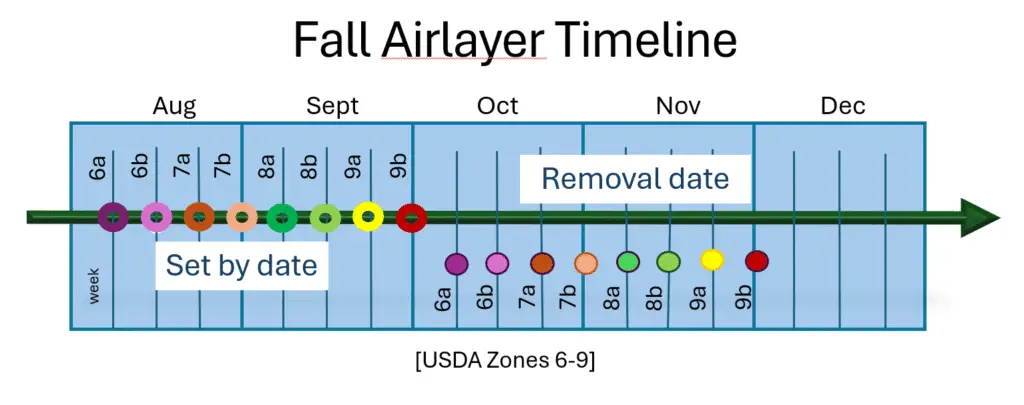

Timeline for setting air layers based on zone.
Inground vs In Pots
If you want to set air layers and still have enough time for the roots to develop before needing to pot them up and move them to a greenhouse or garage for the winter cold. Then you need to consider whether your figs are inground or in pots.
If your figs are inground then you should have a shorter growing season, and therefore need to start the air layers earlier, and take them of sooner leaving less time for root development.
If your figs are in pots you will probably have a longer growing season especially if you have a greenhouse that is warm enough for root growth, if not you will not gain anything from starting earlier and leaving the air layers on longer, in fact you might be worse off, as the moist environment could simulate mold and fungus growth.

Types of air layers.
Plastic ball air layers.
- Small ball 1 and 1/2″ I think, these are the only clear balls I’ve ever used and they seemed to do more poorly than the 3″ black balls but that’s like comparing plums and oranges ones twice the size of the other and that might well be the reason the small balls seem to have a much lower success rate, I left a few of these on too long and during the summer the figs trunk grew enough to pop the ball open. I will give them a second chance and see how they do in the spring, but so far, I have not been impressed.
- Medium ball 3″ diameter, these are my go-to option for air layering, they are pretty pricey but if I get 3 or more uses out of it that’s fine with me. In general, I use the 3″ for larger plants that the small balls can’t fit on. The 3″ balls are big enough that I don’t have to water every day or two and let the roots grow enough to support a few leaves and have less shock from potting up.
- Clear vs Black, some balls are clear on both sides of the clamshell, some are half black and half clear and some are completely black. Personally, I like the half and half ones the best so I can see into the root zone, but I only just started to use these and the air layers I set have not yet rooted, I will reserve final judgement until I am able to remove them and see the success rate. I have had very good success rate in the past with the solid black balls and have yet to try the fully clear ones.
Mediums typically used in air layering.
- Coco Coir, which is my favorite medium for air layering, the main pros being: it holds water very well, and it holds together well when you are setting the air layer, it’s a bit pricey but not prohibitively so.
- Long Fiber Sphagnum moss (LFSM), this is my second choice and is behind coco coir only because of the cost, it holds water a least as well and holds together even better than coco coir when setting the air layer, in addition it has some antibacterial properties, the only con I can think of is that when rooting in LFSM the plant will make a more brittle, and easier to snap root, so this might be a problem when potting up the plant.
- There are other mixes out there but in general you want something that holds water well, and holds together somewhat when wet, though this is of less concern. I do not recommend something with a lot of perlite or D.E., because this lowers water retention. Promix might work ok from what I’ve seen its mostly peat moss and only a little bit of perlite, but I have not experimented with it. If you want more information about mediums and mixes, I recommend you check out the potting mixes page here: Potting Mixes.

